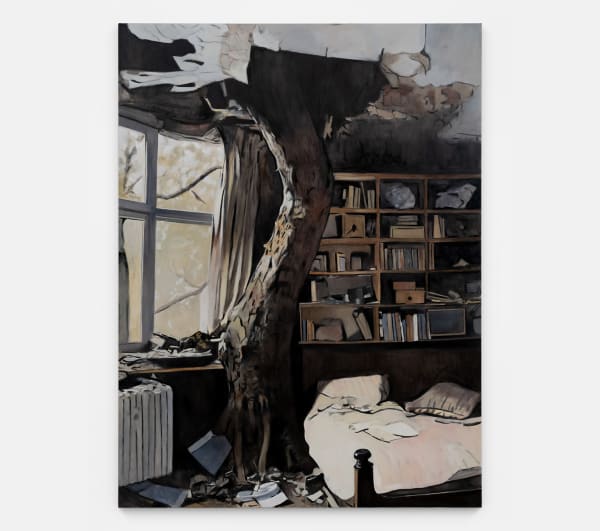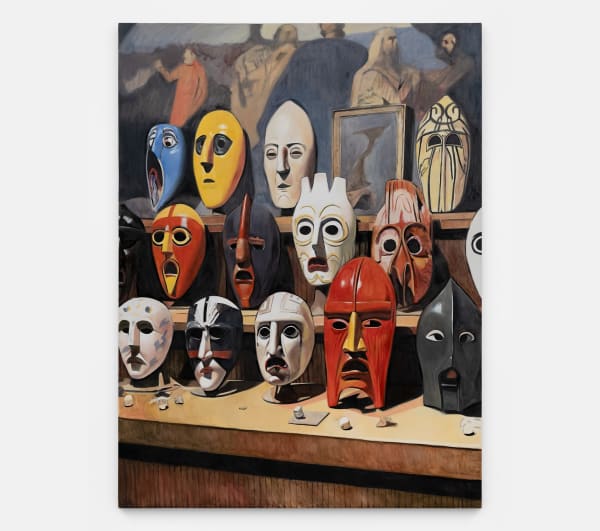Oliver Clegg: always right, sometimes left.
-
Biography

-
Works
-
 Oliver CleggA leap forward from earlier mechanical systems, 2025Oil on linen80 x 60 in (203.2 x 152.4 cm)
Oliver CleggA leap forward from earlier mechanical systems, 2025Oil on linen80 x 60 in (203.2 x 152.4 cm) -
 Oliver CleggTo weave is to wind, 2025Oil on linen80 x 60 in (203.2 x 152.4 cm)
Oliver CleggTo weave is to wind, 2025Oil on linen80 x 60 in (203.2 x 152.4 cm) -
 Oliver CleggSomeone else will always wants us to be their slave, 2025Oil on linen80 x 60 in (203.2 x 152.4 cm)
Oliver CleggSomeone else will always wants us to be their slave, 2025Oil on linen80 x 60 in (203.2 x 152.4 cm) -
 Oliver CleggI genuinely love how my memory worsens with age—every time I see something it feels like the first time., 2025Oil on linen80 x 60 in (203.2 x 152.4 cm)
Oliver CleggI genuinely love how my memory worsens with age—every time I see something it feels like the first time., 2025Oil on linen80 x 60 in (203.2 x 152.4 cm) -
 Oliver CleggYou will find beauty everywhere, 2025Oil on linen80 x 60 in (203.2 x 152.4 cm)
Oliver CleggYou will find beauty everywhere, 2025Oil on linen80 x 60 in (203.2 x 152.4 cm) -
 Oliver CleggAll we need in life is just a little love to take the pain awayyyyy, 2025Oil on linen80 x 60 in (203.2 x 152.4 cm)
Oliver CleggAll we need in life is just a little love to take the pain awayyyyy, 2025Oil on linen80 x 60 in (203.2 x 152.4 cm) -
 Oliver CleggOftentimes I think I have discovered something, I realise a poet has been there before me, 2025Oil on linen80 x 60 in (203.2 x 152.4 cm)
Oliver CleggOftentimes I think I have discovered something, I realise a poet has been there before me, 2025Oil on linen80 x 60 in (203.2 x 152.4 cm) -
 Oliver CleggPieces of the puzzle that I'm always assembling, 2025Oil on linen80 x 60 in (203.2 x 152.4 cm)
Oliver CleggPieces of the puzzle that I'm always assembling, 2025Oil on linen80 x 60 in (203.2 x 152.4 cm) -
 Oliver CleggFull stop., 2025Oil on linen80 x 60 in (203.2 x 152.4 cm)
Oliver CleggFull stop., 2025Oil on linen80 x 60 in (203.2 x 152.4 cm)
-
-
Text
We seek peace and end up with drama.
We seek freedom and end up in debt.
We seek balance and end up with tension.
If artists are known–or at least prone–to holding up a mirror to society, then what does Oliver Clegg's work reflect? His fantastical surrealities, exemplified in a new show of paintings at The Journal Gallery in Los Angeles, resemble the familiar features of modern life not even slightly.
A massive wave breaking through a window out of nowhere into a classic and serene artist's studio. A genteel trio of armchairs around a round table, flooded with sunlight–and water, as evidenced by a ceiling of little waves lapping overhead. An entire garden's worth of flowers bursting into bloom, but inside a faded room, like some runway funereal mold.
Boiling away in a strong palette of lights and darks, the strong chiaroscuro effect only heightens these natural-intrusion dramas, as does the painterly, rough brushwork that softly undercuts what online appears almost photorealistic–in person, it's clear that these owe more to Sargent than Close.
But the tension only starts there. As mildly and surreally clever as Clegg's vignettes might first seem to the scrolling observer–catching waves in a jar?–once his charmingly nostalgic sense of decay and wabi-sabi get under your skin, far weightier issues of temporality, mortality and morality start taking over like fungus.
Clegg loves the pictorial power of depicting force–a fact immediately apparent in his vision of exploding televisions or the unearthly updraft sending a swarm of waiting-room chairs soaring skyward. But quieter and more persevering forces are also at work, as in that massive, gnarled tree that millimeter by millimeter has slowly ploughed its way through both the floor and ceiling of a house in its way.
Clegg, who was born in the U.K. and studied classical painting methods in England and Italy before decamping first to the concrete jungle of New York, then the real jungle of Costa Rica, vividly remembers once visiting a long- abandoned mental institution where nature had taken its course. Ever since, he's remained inspired by entwined convergences of the natural and artificial worlds, which every day diverge in more foundational ways. As human civilization grows increasingly fragile, more focused and consumed by technical, temporary drives, the slow but unyielding growth of nature becomes ever more foreign even as we try and control it.
And therein lies the rub. Scrolling through nature on Instagram can feel good–but you're scrolling through it, not strolling through it.
And that is why when Clegg holds up a mirror, it's a warped, mirrored tunnel from a circus funhouse, lights flashing like a pinball machine, with a mirage of placid nature, far-off and out-of-reach. But Clegg's paintings aren't judging who we are, preaching about a return to Eden and a rejection of modern ways. (We've been trying that for thousands of years, and it hasn't exactly paid off.) Instead his work forges a beautiful but uneasy truce with who and what we are, as well as where and when. So is he depicting balance–or tension? Is there a difference?
Yes, some pop gurus maintain that if you stop chasing dopamine or whatever online and seek peace in nature, you'll find happiness. But then you're just chasing peace. Clegg would just as soon paint how he sees and feels the fragile peace we have right now. If it looks more like drama, well, maybe you just have to make your peace with that.David Colman
-
Q&A
-
Installation Views


















